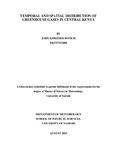| dc.description.abstract | The increasing concentration of greenhouse gases brought about by human activities has been thrown into sharp focus by the adverse effects of climate change on the environment. As part of the important steps to achieving a healthy environment, a study of the fluxes and transport into the country of these gases is necessary. The objective of this study is to assess the concentrations of greenhouse gases in Central Kenya. An investigation was carried out to establish their spatial and temporal distributions, transport and the source regions. The impact of the surrounding area on the background monitoring station of Mount Kenya was also investigated. The study period was from the year 2002 to 2010 and the major greenhouse gases considered were Carbon Dioxide, Methane and Ozone. The data sets used were from the Kenya Meteorological Department for the ozone and rainfall data sets, the global meteorological reanalysis data sets from the National Center for Environmental Prediction- National Center for Atmospheric Research (NCEP- NCAR), and the greenhouse gases data were from the Greenhouse Observing satellite (GOSAT) and the Air resources Laboratory (ARL) of the National Oceanic and Atmospheric Administration of the USA. Air filled flasks from the Mt Kenya GAW Station were analysed for greenhouse gases from December 2003 to November 2011 at the ARL. Statistical and graphical methods were used to assess the spatial and temporal distributions of the greenhouse gases in Central Kenya and to investigate for any correlations or trends. The Hybrid Single - Particle Lagrangian Integrated Trajectory (HYSPLIT) model generated trajectories were used to investigate the transport of the greenhouse gases into the region. The Grids Analysis and Display System (GrADS) was deployed to display the spatial distribution of the greenhouse gases as observed by GOSAT over the country. Another tool, ArcView GIS, was used to show the spatial distributions of the fluxes of Carbon dioxide from fossil fuel and the biosphere.
This study confirmed that there are six different pathways of air transport into the country. These are from the North, North East from Saudi Arabia through Somalia, from India and Pakistan, East from the Indian Ocean, South East from the South West Indian Ocean and Madagascar and from the West. Another significant circulation is the recirculation within the country, especially in the months of July and August. High Ozone is injected into the
country from the North - East from the Arabian Peninsula. Much lower values were recorded with the maritime air but the recirculation in the country showed a more uniform and higher concentration than the maritime air. The trend analysis showed an increasing trend in July and August though not yet statistically significant. A contrast was found in the diurnal variation of tropospheric Ozone over Mt Kenya and at Nairobi. There is a night maximum in Mt Kenya and a minimum in the afternoon. The converse is true for Nairobi where an afternoon maximum occurs; possibly due to a photochemical production during daylight in the presence of ozone precursor gases. The spatial distribution of the carbon dioxide flux from fossil fuel showed the cities of Nairobi and Mombasa registering high emissions. The dominant fossil fuel flux was centred at Nairobi and is up to ten times that of the rest of the country. It spreads out to the surrounding eleven counties of Kiambu, Nyandarua, Nakuru, Narok, Kajiado, Muranga, Machakos, Embu, Kirinyaga, Nyeri, Meru and parts of Makueni and Laikipia. The flux of the biosphere closely follows the march of the rainfall pattern and amounts in the country. The Carbon dioxide column concentration has a bimodal seasonal distribution and divides the country into two. From June to November the eastern parts of the country, together with Mt Kenya GAW station register lower amounts and the western half has higher values. From December to May, the high Carbon dioxide amounts are to the north and northwest of the country; low amounts are to the southern parts, including the Mt Kenya GAW Station. The lowest amounts occur in December in the central parts of the country. The seasonal distribution of surface Ozone shows a seasonal high in March and September. A minimum occurs in December. The Methane temporal distribution shows high values in November to February and this could be due to the higher concentrations in the northern hemisphere air. A minimum occurs in April - May and the low amounts continue into October. These findings can be incorporated into any analysis for the greenhouse gases‟ emissions in environmental impact assessments reports for commercial and industrial projects. They inform the background patterns. The health authorities are encouraged to take appropriate actions and greater concern during the months of June to August incase of any rising amounts of ozone. Further, the Mt Kenya GAW Station is well placed to continue the background monitoring of greenhouse gases. | en |

